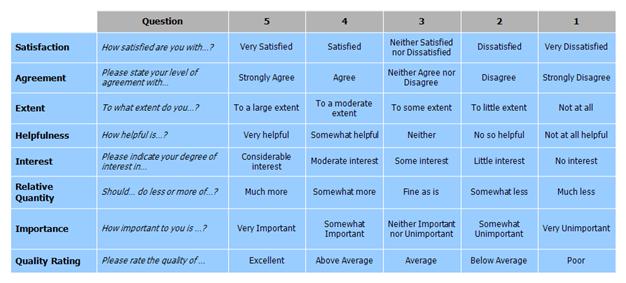


Related answers: Items should be easily related to the sentence’s answers, regardless of whether the relationship between item and sentence is evident.Some significant characteristics of the Likert scale, are: These scales range from a group of general topics to the most specific ones that ask respondents to indicate their level of agreement, approval or, belief. The Likert scale came into existence in 1932 in the form of the 5-point scale, which these days are extensively used. 9-point Likert scale: A 9-point Likert scale is quite uncommon, but you can use it by adding two more answer options to the 7-point Likert scale question.7-point Likert scale: The 7-point Likert scale adds two more answer options at extreme ends of a 5-point Likert scale question.5-point Likert scale: With five answer options, researchers use this odd Likert scale question to gather information about a topic by including a neutral answer option for respondents to select if they don’t wish to answer from the extreme choices.Researchers use the odd Likert scale to give the respondents the choice of responding neutrally.

8-Point Likelihood of recommendation: This is a variation of the previously explained 4-point Likert scale, the only difference being, this scale has eight options to collect feedback about the likelihood of a recommendation.Here the various degrees of importance are represented in a 4-Point Likert Scale. 4-Point Likert Scale for importance : This type of Likert scale allows researchers to include four extreme options without a neutral choice.Researchers use even Likert scales to collect extreme feedback without providing a neutral option. You can divide this scale primarily into two major types: The Likert Scale has become a favorite among researchers to collect opinions about customer satisfaction or employee experience. Learn more: Thurstone vs Guttman Scale Types of Likert scales with examples Therefore it goes from a complete agreement to a complete disagreement, assuming that attitudes can be measured. Likert scale assumes that the strength and intensity of the experience are linear. These scales allow determining the level of agreement or disagreement of the respondents. When responding to an item on the Likert Scale, the user responds based explicitly on their agreement or disagreement level. The other way to frame this question is, “Please state your satisfaction level with the products,” and the options ranging from very dissatisfied to very satisfied. He/ she frames the question as “The product was a good purchase” with the options listed as agree or disagree. Example of a Likert scale:įor example, to collect product feedback, the researcher uses a Likert Scale question in the form of a dichotomous option question. Responses are measured in a range of values. Psychologist Rensis Likert established a distinction between a scale that materializes from a collection of responses to a group of items (maybe 8 or more). Researchers often use this psychometric scale to understand the views and perspectives towards a brand, product, or target market.ĭifferent variations of Likert scales are focused directly on measuring people’s opinions, such as the Guttman scale, Bogardus scale, and Thurstone scale. Definition: A Likert scale is a unidimensional scale that researchers use to collect respondents’ attitudes and opinions.


 0 kommentar(er)
0 kommentar(er)
